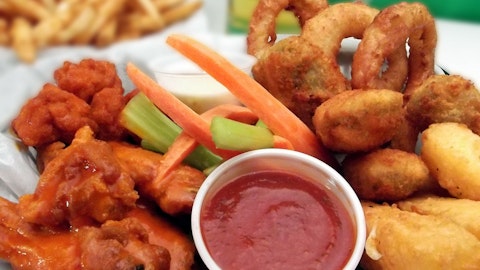David Tarantino: Great. Thank you very much.
Operator: The next question is from Sara Senatore with Bank of America. Please go ahead.
Sara Senatore: Hi. Thank you very much. Just a question and a quick follow-up please. The question is on the food cost you mentioned. I know that you’ve done a nice job with callers and hedging. But when I look at some of your inputs like chicken wings or even breast prices they’ve come up a lot. So I’m just trying to understand your confidence in 2024. Is it because of this mix shift towards boneless and so it’s sort of structural? Or is this maybe perhaps more of a timing where 2024 looks okay but then some of the hedging — or the contracts roll off and perhaps after that you see some of the impact of the recent increase in input plus prices? And then I have a follow-up as I mentioned.
Alex Kaleida: Hi. Good morning, Sara. This is Alex. It’s really a combination of the factors you mentioned. The size and scale of our buy year-in and year-out and our increase of our boneless mix has made us — has allowed us to enter into different pricing conversations with our suppliers. And for the first time we have visibility into our 2024 food cost, which we shared in our prepared remarks today. It’s something our brand partners are really excited about. We’ve seen volatility before when the Urner Barry has moved. I mean, it’s still today below the five year average well below the five year average of wing prices. But the price arrangements we have in place have moved our buy off the spot market which gives us that visibility into this year as well as into next year.
Sara Senatore: Got it. Thank you. And then on the topic of you having taken very little price, I guess, we’ve heard some about promotional environment getting more intense. Is that something that you’ve observed as well? I think the other thing that’s emerged this quarter is that companies or concepts that have taken less price just seem to be doing better. So I’m just trying to understand, if it’s more about the relative value that has accumulated given how much less price you’ve taken or if there is something that’s going on in the promotional environment.
Michael Skipworth: Hey, Sara, I think for us, I think it plays a little bit into this category of one positioning in that we don’t really feel like we have to get out there and maybe compete in that competitive value or promotional landscape, with other national brands because of the uniqueness of our offering and the differentiation of our cook-to-order and high quality. And so for us, we think that consumers are rewarding us for that indulgent occasion that quality the two components that are highest on some of the guest feedback that we hear and what they’re looking for and where they want to spend their dining out dollars. And we’re able to deliver that within a situation where or an offer that we believe provides great value to guests.
And I think we’ve mentioned this before, but quarter-after-quarter, we continue to measure improvements in our value scores with guests. We think that’s a combination obviously of our offering. But we also think it’s supported by the improvements we’ve been making within the four walls of the restaurants on delivering a great guest occasion. And we’re seeing our guest scores record levels for the brand right now. And so the combination of those two things, I think are allowing us to continue to lean into strategies that’s working. And then if you look at our Q3 results, a 15.3% comp which is substantially all driven by transaction growth, I think that supports a little bit of what we’re saying here.
Sara Senatore: Okay. Thank you so much.
Operator: The next question is from Andy Barish with Jefferies. Please go ahead.
Andy Barish: Hey, guys. I wanted to just get a little bit of clarification on the tech stack and just understanding what’s being piloted in restaurants now that’s different as you look forward to a 2024 launch. I may have missed something there, but if you could just provide us a little bit more color on that that would be helpful?
Michael Skipworth: Yeah, Andy, we’re really excited about the progress we’ve made and where we are today with our proprietary tech stack. And this is end-to-end the entire consumer journey and something we’ve been able to build as we mentioned earlier leveraging the most modern technology. And we think it’s something that’s going to be a step change or even an unlock as we continue to advance our digital transformation and expand our digital business. And this is going to allow us to really lean into personalization really leverage that database that’s over 35 million users strong and lean into hyper-personalization, and leverage things like AI that I think will ultimately impact conversion impact frequency. And so we’re really excited about being in pilot in restaurant and starting to move towards that broader scale rollout, which we said would be in Q2 of 2024
Andy Barish: Great. And then just one follow-up on customer acquisition. You definitely gave a little bit more detail there, in terms of what’s been going on with all the programs over the last year. Is that something new coming kind of out of your tech investment? Or was that studies that you’ve been doing recently on your guests, that you’ve been able to glean results from? Just trying to get a little bit more color on that.
Michael Skipworth: Yes, absolutely. As we see our digital business grow to a record level of 67%, that’s allowed us to gain a lot more data on our guests and be able to learn more about them, where they dine, how they engage with our brand. And as we mentioned on our prepared remarks, having a year under our belt with chicken sandwich where we’ve brought a lot of new guests in, that’s allowed us to really look at and understand, how they engage with our brand, how quickly they return into the brand and then what they buy on that second visit. And that’s providing what we’ve called a halo effect to our overall business. And that new guests that we’re bringing in we mentioned, tends to be Gen Z or Millennials more middle income, less likely to have kids at home, than our core.
And their average ticket is higher, and their boneless mix is higher, which is helping support continued growth in our boneless mix, which is a beautiful thing because it ties directly to our supply chain strategy. That’s allowing us to ultimately impact the unit economics and just further enhance those, which are already best-in-class.
Andy Barish: Okay. Impressive stuff. Thank you.
Michael Skipworth: Thank you.
Operator: The next question is from Joshua Long with Stephens. Please go ahead.
Joshua Long: Great. Thank you for taking my question. When we think about the opportunity to drive boneless mix above that 50% threshold that you called out Alex, just curious in stores that have been driving meaningfully higher mix here now, just curious any sort of strategies or learnings you’ve seen in terms of what’s been successful for getting either that level of awareness up, or just the frequency and engagement with that boneless category higher? And just maybe what that has to — inputs that has into thinking about the broader system.




